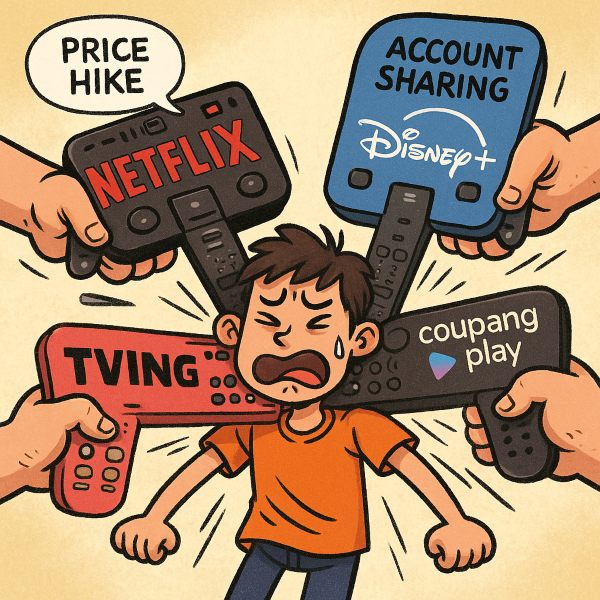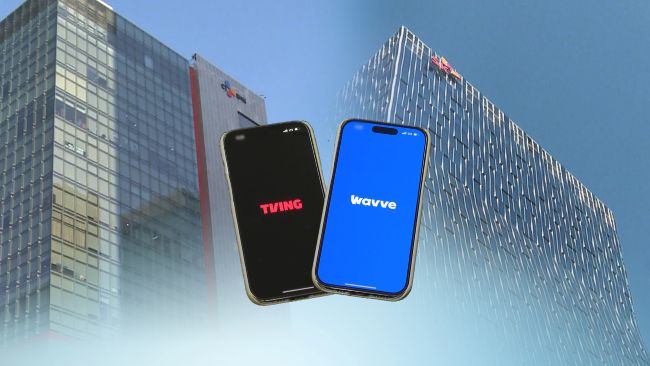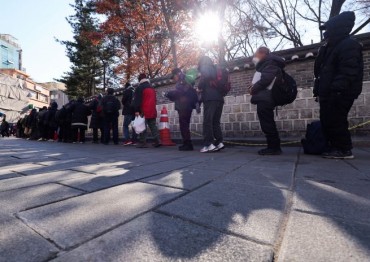
‘Streamflation’ Hits South Korea as Subscription Prices Climb Across Major OTT Platforms (Image supported by ChatGPT)
SEOUL, June 24 (Korea Bizwire) — As inflation continues to pressure South Korean consumers, a new wave of subscription price hikes across major streaming platforms—dubbed “streamflation”—is intensifying household budget strain and fueling public backlash.
Netflix Korea recently raised its ad-supported standard plan from 5,500 won to 7,000 won per month and its basic plan from 9,500 won to 12,000 won. The move follows a series of similar increases across the market: Coupang upped its Wow Membership fee by over 58 percent last August, and Tving raised its annual subscription cost by 20 percent in May.
With terrestrial television losing ground in content competitiveness, many viewers now rely on a mix of OTT services. Subscribing to Netflix, Coupang Play, Tving, and Wavve—the top four platforms in Korea by monthly users—can cost between 20,000 to 30,000 won monthly.
“These price adjustments are understandable given rising content production costs,” said Lee Sung-min, a media professor at Korea National Open University. “But for consumers, the impact is real.”
Many subscribers are now reassessing their streaming habits. “The monthly cost might seem manageable, but it adds up over a year,” said Choi Chul-ho, a 51-year-old office worker, who now limits himself to one platform. Younger viewers are also reconsidering. “I might have to cut back,” said university student Lee Jun-hyung, 25. “It feels like prices are rising everywhere.”
Adding to the discontent are new restrictions on account sharing. Netflix blocked password sharing in early 2024. Disney+ will follow suit for existing users starting June 24, and Tving will begin enforcing similar rules in July.
Coupang Play attracted initial praise this month for introducing Korea’s first ad-supported free streaming plan, but simultaneously launched a new paid tier—“Sports Pass”—that sparked criticism.
Previously included in the basic subscription, live sports content now requires an additional 9,900 won monthly, or 16,600 won for non-members. Premier League, FIFA Club World Cup, and NBA games are among the newly paywalled offerings.
“I used to watch NBA games regularly, but now it’s suddenly locked,” said Kim Jae-min, a 25-year-old student. “I already subscribe to other platforms—it’s becoming unaffordable.”
Tving and Wavve, in a bid to counter consumer fatigue, launched a joint “Double Plan” on June 16—the first integrated pricing model in Korea’s OTT industry.

South Korea’s OTT landscape is undergoing a major shake-up: Tving and Wavve have received conditional approval to merge, potentially creating a domestic streaming giant that could rival Netflix. (Image courtesy of Yonhap)
The plan allows access to select content from both platforms under a single subscription. However, fine print exclusions, including the absence of SBS programming and Apple TV+ content (except on the premium tier), left many users disappointed.
“I’d rather just pay separately,” said office worker Kang Seo-rin, 26. “You still can’t watch SBS shows even with the most expensive plan.”
As consumers voice their frustrations across platforms like X (formerly Twitter) and online forums, the broader discontent signals growing resistance to what many see as opaque pricing models and shrinking value in subscription streaming.
“Small print exclusions, multiple plan tiers—everything’s so confusing,” wrote one user. “This new ‘Double Plan’ feels more like a flashy gimmick than real savings.”
In an era where nearly everything except wages is rising, the streaming wars have entered a new phase—one in which consumers may be less willing to play.
Lina Jang (linajang@koreabizwire.com)







